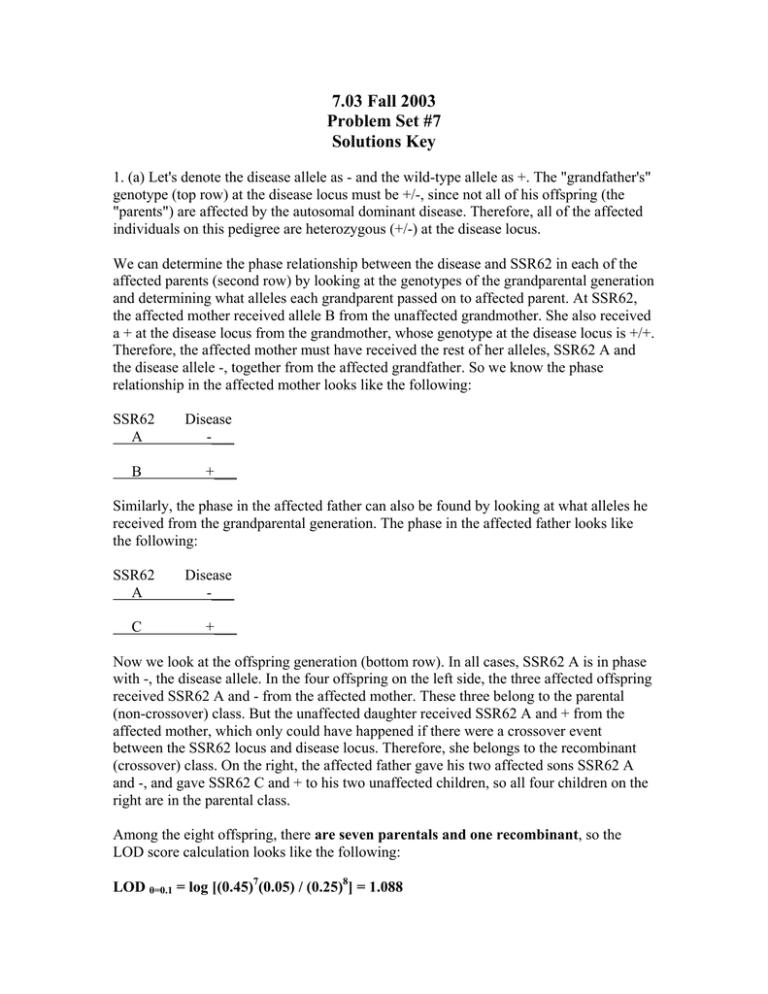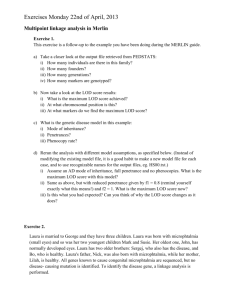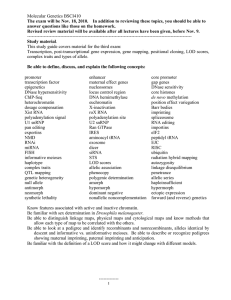7.03 Fall 2003 Problem Set #7 Solutions Key
advertisement

7.03 Fall 2003
Problem Set #7
Solutions Key
1. (a) Let's denote the disease allele as - and the wild-type allele as +. The "grandfather's"
genotype (top row) at the disease locus must be +/-, since not all of his offspring (the
"parents") are affected by the autosomal dominant disease. Therefore, all of the affected
individuals on this pedigree are heterozygous (+/-) at the disease locus.
We can determine the phase relationship between the disease and SSR62 in each of the
affected parents (second row) by looking at the genotypes of the grandparental generation
and determining what alleles each grandparent passed on to affected parent. At SSR62,
the affected mother received allele B from the unaffected grandmother. She also received
a + at the disease locus from the grandmother, whose genotype at the disease locus is +/+.
Therefore, the affected mother must have received the rest of her alleles, SSR62 A and
the disease allele -, together from the affected grandfather. So we know the phase
relationship in the affected mother looks like the following:
SSR62
A
B
Disease
-___
+___
Similarly, the phase in the affected father can also be found by looking at what alleles he
received from the grandparental generation. The phase in the affected father looks like
the following:
SSR62
A
C
Disease
-___
+___
Now we look at the offspring generation (bottom row). In all cases, SSR62 A is in phase
with -, the disease allele. In the four offspring on the left side, the three affected offspring
received SSR62 A and - from the affected mother. These three belong to the parental
(non-crossover) class. But the unaffected daughter received SSR62 A and + from the
affected mother, which only could have happened if there were a crossover event
between the SSR62 locus and disease locus. Therefore, she belongs to the recombinant
(crossover) class. On the right, the affected father gave his two affected sons SSR62 A
and -, and gave SSR62 C and + to his two unaffected children, so all four children on the
right are in the parental class.
Among the eight offspring, there are seven parentals and one recombinant, so the
LOD score calculation looks like the following:
LOD θ=0.1 = log [(0.45)7(0.05) / (0.25)8] = 1.088
We are not finished yet. We must also consider the three parents in the middle row.
However, we do not know the phase of the affected grandfather, so the LOD score
calculation for the three middle row parents will involve the phase unknown formula. The
two possible phases for the affected grandfather are:
SSR62
A
B
SSR62
B
A
Disease
-___
Phase I
+___
Disease
-___
Phase II
+___
In the middle row, the two affected parents in got SSR62 A from the affected
grandfather, while the unaffected female got SSR62 B from the affected grandfather. So
if we assume phase I, there are three parentals. If we assume phase II, there are
three recombinants. The LOD score calculation would look like the following:
LOD θ=0.1 = log {[0.5(0.45)3 + 0.5(0.05)3] / (0.25)3} = 0.465
The total LOD score for linkage between SSR62 and the disease in this family would be
the sum of the two scores, since the events are independent of each other.
LOD θ=0.1 = 1.088 + 0.465 = 1.553
(b) Using the same reasoning as in part a, we can determine the phase relationship between SSR93 and the disease in the affected mother and father: Affected mother: SSR93
Disease B
-___
A
+___
Affected father:
SSR93
Disease
B
-___
A
+___
Now that we know the phase, we must look at the eight offspring. The only recombinant
is the unaffected daughter on the right side, who received SSR93 B and + from the
affected father. All the other seven offspring are parentals, since they received from the
affected parents either SSR93 B and - or SSR93 A and +.
Again, there are seven parentals and one recombinant. So the LOD score is the same
as in part (a):
LOD θ=0.1 = log [(0.45)7(0.05) / (0.25)8] = 1.088
Again, we must also consider the three parents in the middle row. The two possible
phases for the affected grandfather are:
SSR93
B
C
SSR93
C
B
Disease
-___
Phase I
+___
Disease
-___
Phase II
+___
In the middle row, the two affected parents both got SSR93 B from the affected
grandfather, while the unaffected female got SSR93 C from the affected grandfather. So
if we assume phase I, there are three parentals. If we assume phase II, there are
three recombinants. The LOD score calculation would look like the following:
LOD θ=0.1 = log {[0.5(0.45)3 + 0.5(0.05)3] / (0.25)3} = 0.465
The total LOD score for linkage between SSR93 and the disease in this family would be
the sum of the two scores, since the events are independent of each other.
LOD θ=0.1 = 1.088 + 0.465 = 1.553
(c) To calculate linkage between the two SSR's, we disregard whether a person is affected
or unaffected and turn our attention exclusively to the SSR genotypes. We are no longer
restricted to following the alleles of the two affected parents. Therefore, we can consider
the passage of alleles from all four parents and the two grandparents to their respective
offspring independently:
(i) Left side middle row father: This father is homozygous for SSR62 C. Therefore, he is
uninformative for the LOD score calculation, since crossing over between the SSR62
and SSR93 loci will make no difference in the alleles that are passed on (i.e. we cannot
distinguish between recombinant and parental classes).
(ii) Left side middle row mother: This mother is heterozygous at both SSR loci, so she is
statistically informative. We can also determine her phase by looking at what alleles she
received from the grandparents. From the grandmother, she definitely received SSR93 A
and SSR62 B, so these two alleles are in phase. Therefore, she received her other alleles,
SSR62 A and SSR93 B, together from the grandfather. Her phase looks like the
following:
SSR62
A
B
SSR93
B___
A___
Looking at the four offspring on the left, we can see that they all received SSR62 C from
their father and SSR62 A from their mother. At SSR93, three offspring received SSR93 B
from their mother. They are parentals, since SSR62 A and SSR93 B are in phase. The
unaffected daughter received SSR93 A and SSR62 A from her mother. This could only
have happened if there were a crossover between the two SSR loci, so she is a
recombinant. With three parentals and one recombinant, the LOD score calculation
looks like the following:
LOD θ=0.1 = log [(0.45)3(0.05) / (0.25)4] = 0.067
(iii) Right side middle row father: This father received SSR93 A and SSR62 C from the
grandmother, so these two alleles are in phase. Therefore, he received his other alleles,
SSR62 A and SSR93 B, together from the grandfather. His phase looks like the
following:
SSR62
C
A
SSR93
A___
B___
Looking at the four offspring on the right, we can see that there are again three parentals
and one recombinant. The first two sons both received SSR62 A and SSR93 B from their
father and the last son received SSR62 C and SSR93 A from the father. So these three are
the parentals. The daughter received SSR62 C and SSR93 B from the father. She is a
recombinant. With three parentals and one recombinant, the LOD score is the same as
above in (ii):
LOD θ=0.1 = log [(0.45)3(0.05) / (0.25)4] = 0.067
(iv) Right side middle row mother: This mother is homozygous for SSR93 C, so she is
uninformative for the same reason as the left side father.
(v) Top row grandfather: The phase relationship between the two SSRs is unknown in
this individual. The two possible phases are:
SSR62
A
SSR93
B__
B
Phase I
C___
SSR62
B
SSR93
B _
A
Phase II
C___
In the middle row, the three parents (left to right) received the following SSRs from the
grandfather: SSR62A SSR93B, SSR62B SSR93C, and SSR62A SSR93B. So if we
assume phase I, there are three parentals. If we assume phase II, there are three
recombinants. The LOD score calculation would look like the following:
LOD θ=0.1 = log {[0.5(0.45)3 + 0.5(0.05)3] / (0.25)3} = 0.465
(vi) Top row grandmother: She is uninformative because she is homozygous at the
SSR93 locus.
We can add the LOD scores for the left side mother, right side father, and the
grandfather because they passed on alleles to their offspring independently (for the same
reason we can add the LOD scores from different families). So the final LOD score for
linkage between SSR62 and SSR93 in this family is:
LOD θ=0.1 = 0.067 + 0.067 + 0.465 = 0.599
(d) From now on, the alleles for SSR93 will be known as A', B', and C'. To determine the
relative order of the three markers, we must look at the two individuals who were
considered recombinants in parts (a) and (b). In part (a), the recombinant individual is the
unaffected female in the last row (second from left). She received the following alleles
from her affected mother: A, A', +. In the affected mother, the three possible allele orders
are (phase known):
62
A
93 disease
B'
-
B
A'
93
B'
62
A
order 1
+__
disease
order 2
A'
B
+__
62
A
disease
-
93
B'
B
+
order 3
A'__
Since we know that the mother gave the unaffected daughter A, A', +, we look at how
many crossovers are required to give these three alleles together. In orders 1 and 3, one
crossover is needed. But in order two where SSR62 is in the middle, a double crossover is
needed. Since a single crossover is much more likely than a double crossover, we can
rule out order 2 and conclude that SSR62 cannot be the middle marker. However,
we cannot distinguish which of the two other orders is more likely, so we need to look at
another recombinant individual (the one from part b).
We now shift our attention to the unaffected daughter on the right side of the family
(bottom row, second from right). She got the following alleles from her affected father:
C, B', +. In her affected father, the three possible orders were:
62
A
93 disease
B'
-
C
A'
93
B'
62
A
A'
C
+__
62
A
disease
-
93
B'
C
+
order 1
+__
disease
order 2
order 3
A'__
Now we use the same logic to eliminate order 1 so SSR93 cannot be the middle marker
(i.e. there would have had to been a double crossover in order 1 for the father to give C,
B', and + alleles together to the daughter).
This analysis leaves order 3 as the most likely order:
SSR93
disease
SSR62
Note: the best solution to this question (the one described above) was very subtle and
required a familiarity with material introduced earlier in the course, namely the
superiority of three factor crosses in determining genetic order and distance. A common
incorrect solution to this problem involved using the LOD scores calculated in earlier
parts to predict order. This method is weaker because LOD scores essentially measure
two factor distances (they are two factor crosses between two markers).






